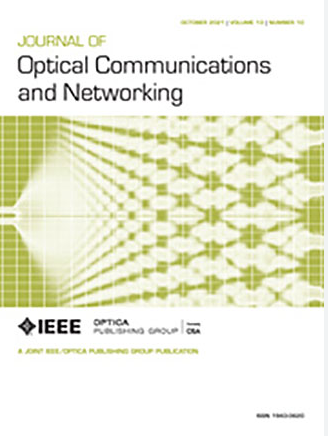sdn支持的CV-QKD和经典信道共存:密集波分复用的关键见解
IF 4.3
2区 计算机科学
Q1 COMPUTER SCIENCE, HARDWARE & ARCHITECTURE
引用次数: 0
摘要
本文探讨了影响连续可变量子密钥分发(CV-QKD)和经典信道(CC)在 C 波段密集波分复用(DWDM)中共存的各种物理层参数。这些参数包括传输量子符号的数量、CC 的功率水平、C 波段内量子信道(QC)的分配、CC 之间的功率分布、CC 和 QC 之间的信道间距以及适合 CC 和 QC 的 CC 功率范围。这些见解为软件定义网络(SDN)控制系统有效管理 CV-QKD 和 CC 共存提供了宝贵的指导。我们观察到,对于短距离和较低的密钥速率,交换的量子符号数不需要达到渐近收敛极限。然而,要在 10 千米链路上实现渐近机制,需要传输约 ${1} \times {{10}\次{{10}^{13}}$量子符号。CC 功率对 CV-QKD 性能有很大影响。例如,在 DWDM 设置中,100 GHz 网格上有 37 个哑 CC,当 QC 位于 193.2 THz 且 QC 与 CC 之间保持 200 GHz 信道间距时,CV-QKD 在 10 km 链路上可支持高达 11 dBm 的总发射功率。在 C 波段内战略性地放置 QC 也能提高性能。将 QC 放在相对于 CC 更高频率的信道上,可提高密钥分数和 CC 的最大支持功率。例如,将 QC 设置在 195.9 THz 比设置在 193.2 或 192.2 THz 性能更好。但是,当 QC 位于 192.2 THz 时,支持的 CC 最大功率会降低到 9.8 dBm。此外,功率分布与功率集中之间的关系非常复杂,需要仔细考虑。它取决于活动 CC 的数量、CC 的功率以及它们相对于 QC 的频谱位置。我们还分析了 ${8} 的情况。\times {200}\{rm G}$ 调制 CC 的情况,并发现将它们放置在距离 QC 100 GHz 的位置会引入非线性噪声,但仍能获得正秘钥分数。将间距增加到 200 GHz 可进一步提高 CV-QKD 性能。联合性能分析表明,在 100 GHz 间距和 CC 光信噪比为 30 dB 的条件下,{-}{16.96}$ 至 9.03 dBm 的发射功率范围可支持 10 km 链路上的无差错 CC 恢复和正密钥率生成。这项全面分析强调了 CV-QKD 和 CC 之间的相互作用,并提供了通过 SDN 控制系统优化它们在 DWDM 系统中共存的实用策略。本文章由计算机程序翻译,如有差异,请以英文原文为准。
SDN-enabled CV-QKD and classical channels coexistence: key insights for dense wavelength division multiplexing
In this paper, we explored various physical-layer parameters affecting the coexistence of continuous-variable quantum key distribution (CV-QKD) and classical channels (CCs) within dense wavelength division multiplexing (DWDM) in the C-band. These parameters include the number of transmitted quantum symbols, power levels of CCs, quantum channel (QC) allocation within the C-band, power distribution among CCs, channel spacing between CCs and the QC, and CC power ranges suitable for both CCs and the QC. These insights provide valuable guidance for a software-defined networking (SDN) control system to manage CV-QKD and CC coexistence effectively. We observed that, for short distances and lower key rates, the number of quantum symbols exchanged does not need to reach the asymptotic convergence limit. However, achieving the asymptotic regime on a 10 km link requires transmitting approximately ${1} \times {{10}^{13}}$ quantum symbols. CC power significantly impacts CV-QKD performance. For example, in a DWDM setup with 37 dummy CCs on a 100 GHz grid, CV-QKD can support up to 11 dBm total launch power over a 10 km link when the QC is positioned at 193.2 THz and a 200 GHz channel spacing between the QC and CCs is maintained. Strategic placement of the QC within the C-band also enhances performance. Placing the QC at higher frequency channels relative to CCs improves both the secret key fraction and the maximum supported power of CCs. For instance, placing the QC at 195.9 THz provides better performance than positioning it at 193.2 or 192.2 THz. However, when the QC is placed at 192.2 THz, the maximum supported CC power reduces to 9.8 dBm. Additionally, the relationship between power distribution and power concentration is complex and requires careful consideration. It depends on the number of active CCs, the power of CCs, and their spectral placement relative to the QC. We also analyzed the case of ${8} \times {200}{\rm G}$ modulated CCs and found that placing them 100 GHz from the QC introduces nonlinear noise but still allows a positive secret key fraction. Increasing the spacing to 200 GHz further improves CV-QKD performance. Joint performance analysis revealed that, at a 100 GHz spacing and a 30 dB optical signal-to-noise ratio for CCs, a launch power range of ${-}{16.96}$ to 9.03 dBm supports both error-free CC recovery and positive key rate generation over a 10 km link. This comprehensive analysis highlights the interplay between CV-QKD and CCs, offering practical strategies for optimizing their coexistence in DWDM systems through an SDN control system.
求助全文
通过发布文献求助,成功后即可免费获取论文全文。
去求助
来源期刊
CiteScore
9.40
自引率
16.00%
发文量
104
审稿时长
4 months
期刊介绍:
The scope of the Journal includes advances in the state-of-the-art of optical networking science, technology, and engineering. Both theoretical contributions (including new techniques, concepts, analyses, and economic studies) and practical contributions (including optical networking experiments, prototypes, and new applications) are encouraged. Subareas of interest include the architecture and design of optical networks, optical network survivability and security, software-defined optical networking, elastic optical networks, data and control plane advances, network management related innovation, and optical access networks. Enabling technologies and their applications are suitable topics only if the results are shown to directly impact optical networking beyond simple point-to-point networks.

 求助内容:
求助内容: 应助结果提醒方式:
应助结果提醒方式:


